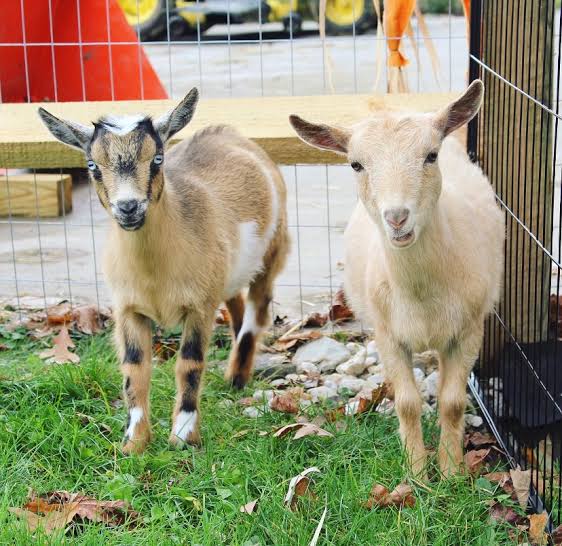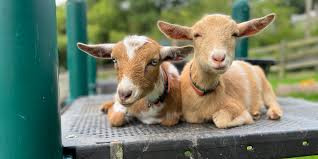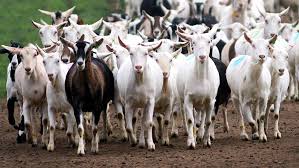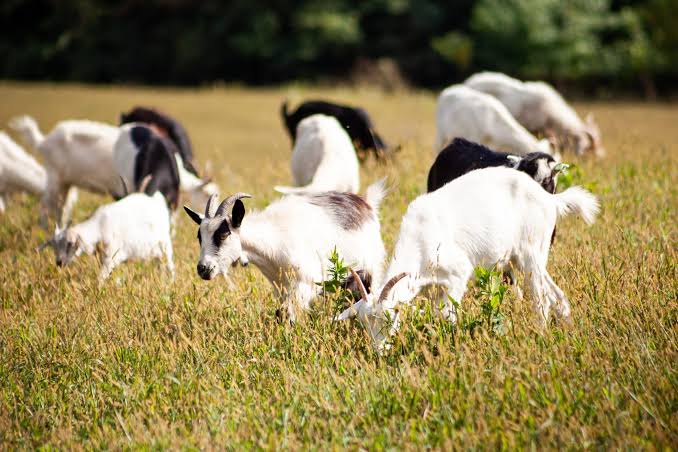Goats are amazing animals, they have soft fur and come in many colors like white, brown, and black. Goats are friendly and like to play with each other. These animals are found all around the world, and people keep them for various reasons. Some keep goats for their milk, which is tasty and nutritious. Goat milk can be used to make cheese and yogurt, too.
Goats are not very picky eaters. They enjoy munching on grass, leaves, and even some bushes. They use their small, sharp teeth to chew their food. Goats have a unique stomach with four compartments that helps them digest tough plants. One interesting thing about goats is their horns. Some goats have big, curved horns, while others have smaller ones. Horns are used by goats to defend themselves or to establish dominance in their group.
These animals are known for their agility. Goats are excellent climbers and can easily navigate steep and rocky terrain. Their hooves are specially designed to help them keep their balance. Goats are social animals that like to stay in groups called herds. Being in a herd makes them feel safe. They communicate with each other using various sounds, such as bleats and grunts.
During the springtime, baby goats, also called kids, are born. They are cute and love to jump and play around. Mother goats, known as does, take good care of their kids, nursing them and keeping a watchful eye. Many cultures have festivals and events celebrating goats. In some places, goat races are organized for fun. Goats are also featured in stories and folklore around the world.
Goats can adapt to different climates, from hot deserts to cold mountains. They are hardy animals and can endure challenging conditions. In addition, goats are fascinating creatures with a lot of qualities. They provide us with milk and cheese, entertain us with their playful antics, and have a special place in various cultures. Next time you see a goat, take a moment to appreciate these wonderful animals and all the joy they bring to the world.
Goats also have a remarkable ability to clear vegetation. Some people use goats to help manage overgrown areas by letting them graze. Their natural grazing behavior is an eco-friendly way to control unwanted plants without the need for harmful chemicals.
In addition to their practical uses, goats can form strong bonds with their human caretakers. Many people find joy in raising goats as pets. These animals can be affectionate and enjoy being petted and groomed. Building a connection with a goat can be a rewarding experience for those who have the time and space to care for these friendly creatures.
Interestingly, goats have rectangular-shaped pupils, providing them with a broad field of vision. This unique eye structure helps them spot predators from various angles. It’s just one of the many adaptations that make goats well-suited to their environments.
Goats are known for their curiosity. They like to explore their surroundings and investigate new objects. This curiosity can sometimes get them into amusing situations, as they may try to climb on structures or investigate things with their noses. The diversity of goat breeds adds to the intrigue of these animals. From the majestic Angora goats with their long, luxurious wool to the small and hardy Nigerian Dwarf goats, each breed has its own characteristics and qualities.
Goats also play a role in sustainable farming practices. Their manure is rich in nutrients, making it an excellent natural fertilizer. Some farmers use goat manure to improve soil health and promote plant growth, contributing to a more environmentally friendly approach to agriculture.
As we appreciate these incredible creatures, it’s essential to recognize the importance of responsible goat ownership. Providing proper shelter, nutrition, and healthcare ensures the well-being of these animals. Goats, with their charming personalities and useful contributions, continue to be cherished members of farms and households around the world.
Read Also: Jersey Cow: Grooming and Care Guide
Appearance and Features of Goats

Goats exhibit a diverse range of appearances and features. Their size can vary widely, with some breeds being small and compact, like the Nigerian Dwarf, while others, such as the Saanen, are larger and more robust.
One distinctive feature of goats is their horns. While not all goats have them, many do, and the size and shape can differ significantly between breeds. Horns can be twisted, curved, or even spiral-shaped. Some goats, particularly certain dairy breeds, are naturally polled, meaning they don’t have horns.
Their fur, known as a coat, also varies in texture and length. Some goats have short, sleek coats, while others, like the Angora goat, have long, luxurious wool. The color of their coats can range from solid white, black, and brown to more intricate patterns and markings.
The rectangular-shaped pupils in goats’ eyes are distinctive and contribute to their excellent peripheral vision. This unique eye structure aids in detecting movement and potential threats, a crucial ability in their natural habitats.
Goats are equipped with hooves that are split into two parts, providing stability and traction on uneven terrain. This adaptation allows them to climb and navigate rocky landscapes with ease. Their hooves continually grow, and regular trimming is necessary for their health and well-being.
In terms of facial features, goats often have expressive eyes and a mobile upper lip, known as a prehensile lip. This lip helps them grasp and manipulate objects, especially when foraging for food.
While not immediately apparent, goats have a specialized stomach with four compartments: the rumen, reticulum, omasum, and abomasum. This complex digestive system enables them to efficiently extract nutrients from fibrous plant materials.
The audible communication of goats is also notable. They use a variety of vocalizations, including bleats, grunts, and sometimes even screams, to convey different messages. These sounds play a role in social interactions within the herd and can express distress, contentment, or a desire for attention.
Overall, the appearance and features of goats showcase their adaptability and unique characteristics, making them fascinating creatures to observe and appreciate.
Health and Lifespan of Goats
Goats, when well cared for, can lead healthy lives with an average lifespan ranging from 10 to 15 years, depending on factors such as breed, genetics, and environmental conditions. Proper nutrition, regular veterinary care, and suitable living conditions are crucial for maintaining their well-being.
One key aspect of goat health is their diet. Goats are natural foragers, and a balanced diet is essential for their overall health. Providing access to fresh, clean water and a variety of forage, including grasses and browse, helps meet their nutritional needs. Additionally, some owners supplement their goats’ diet with minerals to ensure they receive essential nutrients.
Regular veterinary check-ups are essential for preventing and addressing health issues. Vaccinations, deworming, and hoof trimming are routine aspects of goat care. Good hygiene practices, such as keeping living quarters clean and dry, also contribute to preventing illnesses.
Goats are resilient animals, but they can be susceptible to various health challenges. Common issues include internal parasites, respiratory infections, and hoof problems. Observing goats closely for signs of illness, such as changes in behavior, appetite, or appearance, allows for early detection and prompt veterinary intervention.
Reproductive health is another consideration. Female goats, known as does, can start breeding at a young age, and proper management of breeding cycles is important. Castrating male goats, or bucks, if they are not intended for breeding, helps manage their behavior and prevent unwanted pregnancies.
Environmental factors play a role in goat health as well. Shelter from extreme weather conditions, proper ventilation, and adequate space are essential components of their living environment. Goats are sensitive to heat stress, so providing shade during hot weather is crucial.
As goats age, they may experience age-related health issues, such as dental problems. Monitoring their teeth and adjusting their diet accordingly can help address these concerns.
In addition, ensuring the health and well-being of goats involves a combination of proper nutrition, veterinary care, and attention to their living conditions. With the right care, goats can live fulfilling lives as valuable members of farms and households.
Read Also: The History and Origin of Highland Cows
Nutrition and Feeding of Goats

Goats are versatile eaters, exhibiting a feeding mode known as “browsing.” This means they prefer to nibble on a variety of vegetation, including grasses, shrubs, and leaves. Their ability to consume a broad range of plant materials contributes to their adaptability in various environments.
The primary component of a goat’s diet is forage, which includes fresh grass and other plant materials. They use their prehensile lips and mobile upper jaw to grasp and pull vegetation into their mouths. Goats are particularly skilled at reaching high branches and climbing to access browse that other animals might not reach.
Apart from forage, goats benefit from a diet that includes hay, especially during periods when fresh pasture is limited. Hay provides essential fibers and nutrients. Additionally, some goat owners supplement their animals’ diet with grains and concentrates to meet specific nutritional requirements, particularly for those in milk or growing kids.
Mineral supplementation is crucial for maintaining goat health. Providing access to mineral blocks or loose minerals helps ensure they receive essential nutrients like calcium, phosphorus, and trace minerals. Adequate water intake is also vital for proper digestion and overall well-being.
Goats are ruminants, meaning they have a complex stomach with four compartments. This unique digestive system allows them to efficiently break down fibrous plant material. They engage in a process called rumination, where they regurgitate and re-chew their food to enhance digestion.
Balancing a goat’s diet is essential for preventing nutritional deficiencies or imbalances. Goats require a mix of carbohydrates, proteins, vitamins, and minerals to thrive. Monitoring their body condition and adjusting their diet based on life stage, such as pregnancy or lactation, is crucial for optimal health.
However, goats are adaptable eaters with a browsing feeding mode. Providing a well-rounded diet that includes a variety of forage, hay, grains, and minerals ensures they receive the nutrients necessary for their health and vitality. Understanding their unique digestive system and nutritional needs is key to responsible goat ownership.
Grooming and Care for Goats
Grooming and care are essential aspects of keeping goats healthy and happy. Here’s a guide to help you provide the best care for your goats:
1. Shelter: Ensure your goats have access to a well-constructed shelter to protect them from harsh weather conditions, including rain and extreme temperatures.
2. Feeding: Provide a balanced diet consisting of forage, hay, grains, and minerals.
Monitor their body condition and adjust their diet as needed, especially during periods like pregnancy or lactation.
3. Water: Ensure a constant supply of clean, fresh water to keep your goats well-hydrated.
4. Veterinary Care: Schedule regular check-ups with a veterinarian to monitor the health of your goats. Follow vaccination and deworming schedules to prevent common health issues.
5. Hoof Care: Trim your goats’ hooves regularly to prevent overgrowth and discomfort. Check for signs of lameness or infection in the hooves.
6. Dental Care: Monitor your goats’ teeth for signs of wear or dental issues. Provide a diet that encourages natural chewing to maintain dental health.
7. Grooming: Brush your goats regularly, especially during shedding seasons, to remove loose fur and dirt. Check for external parasites such as ticks and lice and take appropriate measures if infestations occur.
8. 8.Social Interaction: Goats are social animals; ensure they have companionship to prevent loneliness. Spend time interacting with your goats to build trust and monitor their behavior for any signs of distress.
9. Reproductive Care: If breeding, carefully manage the breeding cycles of your goats.
Provide appropriate care for pregnant does and monitor kidding (birthing) closely.
10. Fencing: Secure proper fencing to prevent escapes and protect goats from potential predators.
11. Cleanliness: Keep living areas clean and well-drained to prevent the buildup of waste and minimize the risk of disease.
12. Observation: Regularly observe your goats for any changes in behavior, appetite, or health indicators.
Address any signs of illness promptly and seek veterinary assistance when necessary.
By following this guide, you can create a positive environment for your goats, promoting their well-being and ensuring they lead healthy and content lives.
Economic Benefits of Goats

Goats offer various economic benefits, making them valuable assets in agriculture and local economies:
1. Milk Production: Goats are prolific milk producers, providing nutritious milk that can be consumed directly or used to make cheese, yogurt, and other dairy products.
2. Meat Production: Goat meat, commonly known as chevon or mutton, is a popular protein source in many cultures. It is lean and has a distinct flavor.
3. Fiber Production: Certain goat breeds, like Angora and Cashmere goats, produce high-quality fibers used in the textile industry. Angora goats yield mohair, while Cashmere goats provide luxurious Cashmere wool.
4. Land Management: Goats are natural grazers and browsers, making them effective at controlling vegetation. Some farmers use goats to manage overgrown areas, reducing the need for mechanical equipment or chemical herbicides.
5. Manure: Goat manure is a valuable organic fertilizer rich in nutrients. It can be used to improve soil fertility, contributing to sustainable and eco-friendly farming practices.
6. Breeding and Sales: Breeding and selling goats can be a profitable venture. Healthy, well-bred goats are in demand for various purposes, including dairy, meat, and as pets.
7. Weed Control: Goats are adept at clearing out invasive plants and weeds. This natural weed control method is environmentally friendly and can be cost-effective for landowners.
8. Sustainable Farming: Integrating goats into a farm system can enhance sustainability. Their ability to thrive on marginal lands and convert vegetation into valuable products contributes to diversified and resilient agricultural practices.
9. Rural Livelihoods: For many rural communities, goats represent a source of income and livelihood. Small-scale goat farming can empower local farmers, providing economic stability and improving living standards.
10. Ecotourism: In some areas, goat farms attract tourists interested in experiencing rural life, goat milking demonstrations, or participating in goat-related activities. This contributes to local economies through tourism revenue.
11. Research and Development: Goats are subjects of research, leading to the development of improved breeds, feeding practices, and management techniques. This knowledge benefits the agricultural sector and contributes to overall economic development.
In summary, the economic benefits of goats extend beyond traditional farming. Their contributions to milk, meat, fiber, and land management make them valuable assets in sustainable and diversified agricultural systems, positively impacting local economies and livelihoods.
Read Also: Levelset Material Financing: Empowering Construction Projects

